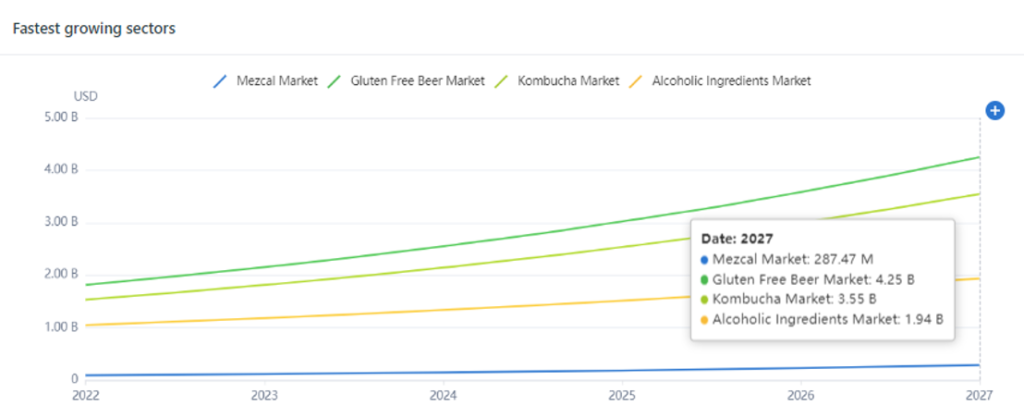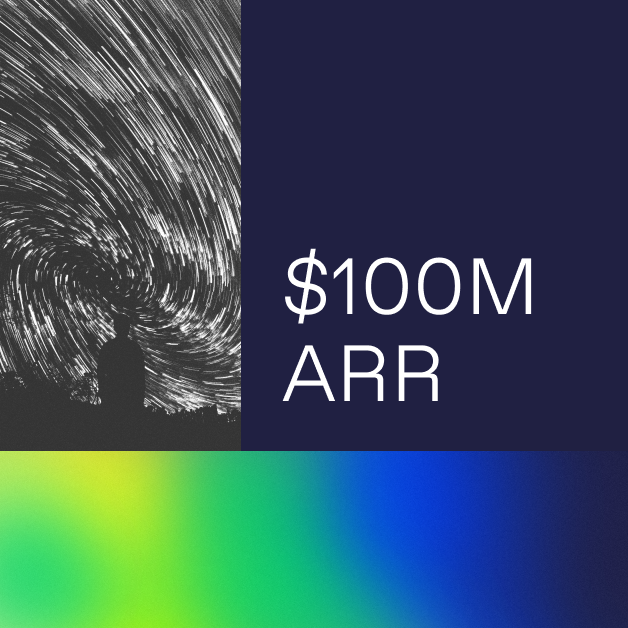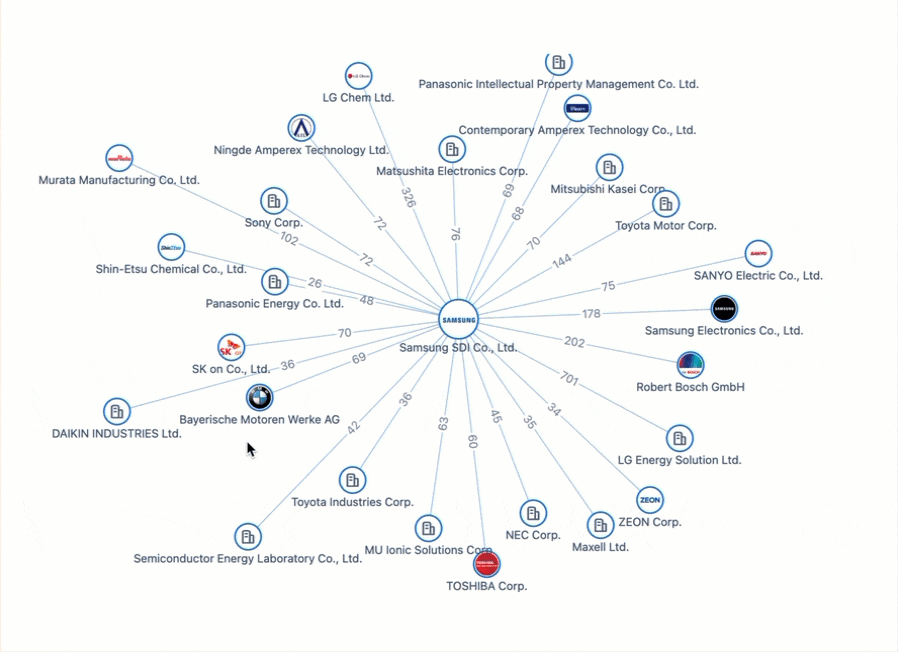7 Key Beverage Industry Trends to Watch Out For in 2023
From functional waters and natural energizers to mocktails and cannabis creations, the beverages market is booming. In this article, we’ll explore 7 key beverage trends to watch out for in 2023.
Since its inception in the 1700s, the beverage industry has grown tremendously. It’s synonymous with some of the most well-known brands including Coca-Cola and Starbucks and has paved the way for breweries, wine bars, and coffee shops.
Although innovation in this industry is often defined by new flavor profiles and line extensions, this is changing. Disruptive applications, including jitter-free energy drinks, functional waters designed to improve consumer health, and cocktail alternatives are hitting the market.
In this article, we’ll look at 7 key beverage industry trends to watch out for in 2023.
Beverage Industry Overview
The beverage industry falls into two categories: alcoholic and non-alcoholic. Drinks that fall into the non-alcoholic category include water, milk and milk varieties, juice, soda, coffee, tea, and energy drinks etc. Alcoholic beverages include beer, wine, and spirits.
The global industry is expected to reach a $1.8 trillion dollar valuation by 2028, with the non-alcoholic sector growing by an estimated CAGR of 6.2%. Given this rapid growth, it isn’t surprising to report that 2022 was a record-breaking year for the industry, with about $1.29 billion raised in new investments.

In terms of sector growth, Gluten Free Beer, Kombucha, Alcoholic Ingredients, and Mezcal are leading the way.

The most successful companies know that in order to be successful, innovations need to reflect what people want.
Beverage Industry Trends
Beverage Industry Trend #1: Subbing Out Sugar
For many people, sugar is a dietary staple found in virtually every processed food or beverage. Unfortunately, overconsumption of it carries risks such as weight gain, type 2 diabetes, certain cancers, and heart issues.
To minimize any negative externalities associated with sugar consumption, and appeal to consumer demand, beverage makers are experimenting with new ingredients. The goal is to deliver the desired sweetness, flavor, texture, and subsequent calorie count consumers want without any of the associated risks. Success requires a solid understanding of the different sweetener innovations already available, like stevia and allulose, as well as developing new blends and uncovering how best to use them.


Research into sugar alternatives is steadily rising and has been for the past 20 years. With soda, juice, energy, and ready-to-drink tea manufacturers jumping on the alternative sugar bandwagon.
Recent production examples include:
- Dr. Pepper Zero Sugar
- Mountain Dew Zero Sugar
- Better Juice
- Red Bull Sugar Free
- Monster Energy Zero
- Brisk Zero Sugar Lemon
Some of the key topics include Xylitol, Erythritol, and Sorbitol. All three of these compounds are sugar alcohols or hybrids of sugar and alcohol molecules. Erythritol, Xylitol, and Sorbitol occur naturally in foods such as fruits and vegetables, however, other sugar alcohols are produced industrially. They are considered low-calorie sweeteners, and they don’t cause tooth decay or elevated high blood sugar levels.
Beverage Industry Trend #2: Creating with Cannabis
Consumer interest in cannabis, also known as THC, is booming, even though both medical and recreational marijuana use remains illegal at the federal level in the US. Since 1996, 33 states have legalized medical marijuana and 11 of those have passed legislation allowing for legal consumption and sale of weed. Although it’s inevitable that cannabis will be a significant part of the beverage market in the future, it’s still considered somewhat risky right now.

Currently, most cannabis patent filings happen in Canada and the US. We’re already beginning to see many large drink corporations, predominantly alcohol companies, creating new products or starting new brands or partnerships with a cannabis focus.
Here are a few examples:
- Molson Coors and its subsidiary, Veryvell, which offers a line of sparkling waters with CBD and adaptogens
- Pabst Blue Ribbon and its non-alcoholic “high seltzers” which contain 10 mg of THC
Anheuser-Busch (the maker of Budweiser) also briefly entered the space before bowing out due to federal illegalities.
Beverage Industry Trend #3: Becoming More Sustainable
In 2020 the Drinks Industry Sustainability Index
gave the beverage industry a 4.8 out of 10, stating the industry is considerably behind others. And that’s not good news, given a 2021 survey conducted by Statista found that 20% of Gen Z and Millennial participants consider how sustainable a food or beverage product is before purchasing it.In an NYU Stern Center for Sustainable Business study, 50% of the consumer-packaged goods (CPG) market growth from 2013 to 2018 is attributable to sustainability-marketed goods. This study also found that products marketed as sustainable grew 5.6 times faster than those that were not.

Unsurprisingly, sustainable packaging is becoming a huge trend in the beverages market. Some of the fastest-growing topics include:
- Cellulose packaging
- Polymer packaging
- Nanocomposites
Buen Vato, a liquor company, recently launched the “world’s first” tequila in a cardboard bottle. The bottle contains 94% recycled material, meaning it’s lighter to transport and better for the planet. Evian, a well-known water company, launched its first-ever sparkling water in recyclable aluminum cans.
Beverage companies can stand out in the market by building sustainability into their products and their supply chain. Whether exploring new options for packing or choosing production partners focused on addressing sustainability issues, building an eco-conscious brand can pay off.
Beverage Industry Trend #4: Pivoting to Mocktails
The global market for non-alcoholic drinks is trending — big time. The market is expected to reach a record value of $1.6 billion by 2024.
Investments in alcohol-free drinks (beer, wine, and spirits) and dealcoholized alternatives are also taking off. In 2022, more than $500 million was funneled into this sector.

What’s more, Google searches like “sober curious” and “cocktail alternatives” are generating thousands of global hits per day, especially among Millennials and Gen Z. Ultimately, as younger generations consume less alcohol and focus instead on healthier alternatives, more companies will pivot to mocktail varieties.
Beverage Industry Trend #5: Replacing Coffee
The average person in the US consumes about two cups of coffee per day. Although most people drink coffee as a morning pick-me-up, it also comes with some unwanted side effects including:
- Anxiety
- Shakiness
- Dehydration
- Insomnia
- Headaches
- Dizziness
- Restlessness
- Increased heart rate
This occurs because caffeine stimulates the release of epinephrine in the body (aka adrenaline) which produces a “fight or flight” like response. To bypass the side effects, many consumers are turning their attention to natural stimulants such as coconut water, green juice, and mushroom coffee.

With 67% of global consumers paying close attention to what they eat and drink, consumer brands are adapting. This is evident in the increasing investments in startups actively working in the space of green or clean energy drinks. And large conglomerates are paying attention too. The chart above showcases Pepsi’s investments and acquisitions over the last few years. In 2022 Pepsi invested in Celsius, as well as Rockstar — two largely successful energy drink companies. It also funneled money into Vita Coco and KeVita, both of which are functional beverage companies.
Beverage Industry Trend #6: Drinking for Better Health
Modern consumers are educating themselves on digestive health, which includes understanding gut bacteria and how it impacts well-being. There’s also a preventative aspect to digestive health, as people aim to reduce the feelings of gas, bloating, or more severe gastrointestinal symptoms.
Fueling our bodies with nutritious foods and beverages is becoming increasingly important, especially as diseases such as colon cancer are on the rise. As a result, the fermented beverages sector is seeing rapid growth. Estimates predict that probiotic beverages will achieve over $77 billion in sales by 2025, almost double the revenue generated worldwide in 2018.

Kombucha is a top trending health drink and one of the fastest-growing market sectors within the beverages industry. As the graph above illustrates, kombucha patent activity is trending upward.
Other fermented and probiotic beverages are also trending. For example, water kefir, which has very diverse probiotic strains that help boost the immune system and aid digestion, is gaining popularity. These beverages, and similar alternatives, are going mainstream so don’t be surprised if you see them at a store near you!
Beverage Industry Trend #7: Drinking Functional Waters
We already know that drinking good old H2O is good for our health, but what about “functional water?” This water type contains healthy additives such as botanicals, vitamins, minerals, and oxygen. Examples include sparkling, flavored, and unflavored varieties. The key commonality is that they all have functional positionings such as better immunity or digestion.
During the pandemic, there was a huge increase in new coverage surrounding the functional water market (see graph below). This shift was, and continues to be, driven by the transition towards healthier living.

By 2025, the functional water market is expected to reach an $18.24 billion dollar valuation. As consumers say goodbye to sugary drinks and hello to healthier alternatives, we expect to see more functional water options hit the market!
Closing Thoughts: Beverage Disruption is Real – and It’s Here to Stay
Like countless other industries, the beverage industry is on the cusp of mass disruption. Shifting consumer preferences, health concerns, and climate change are all impacting how beverages are made, marketed, and sold.
Over the next several years, especially as climate concerns heat up, we expect to see more products made with eco-friendly ingredients and packing. In addition, it’s likely that both seasoned and emerging players will prioritize beverages that enhance health and well-being.
The bottom line? Change is on the horizon, and we can’t wait to sip what’s next.
Your recommended content
-

Patsnap Surpasses US$100 Million in Annual Recurring Revenue
Category: Article | Category: News/PR
Wednesday, June 12, 2024
Patsnap has reached a significant milestone of achieving $100M in Annual Recurring Revenue (ARR), marking an impressive 20% year-over-year growth in 2023. This milestone highlights the massive and meaningful value our platform brings to over 12,000 IP and R&D teams across 50 countries, driving efficiency, productivity, and collaboration.
-

Introducing Hiro, an AI assistant built for IP and R&D workflows
Category: AI advancements | Category: AI development | Category: AI-tools | Category: Article | Category: artificial intelligence
Tuesday, May 14, 2024
Powered by Patsnap’s industry-specific LLM, Hiro is designed to streamline IP and R&D workflows from ideation to product launch. With its robust AI capabilities, Hiro brings a new level of efficiency, precision, and security to tasks that were once time-consuming and labor-intensive.What sets Hiro apart is that it draws from our large language model that’s been trained on market-leading patent records, academic papers, and proprietary innovation data. This ensures we deliver more accurate and reliable results for every prompt.
-

Powering the Future of Electric Vehicles: The Battle for Battery Innovation and Patents
Category: Article | Category: battery technology | Category: electric vehicle | Category: EV | Category: lithium ion | Category: lithium ion battery | Category: NEV | Category: new energy vehicles
Monday, April 22, 2024
In the ever-evolving landscape of innovation, the electric vehicle (EV) industry stands as a beacon of technological transformation. As we explore the patents propelling the EV revolution, Apple's venture serves as a poignant example of the challenges even industry giants face in this competitive arena. Join us on a journey through the global patent landscape, where the quest for superior power solutions unfolds, and where the true pioneers of the EV revolution are making their mark.